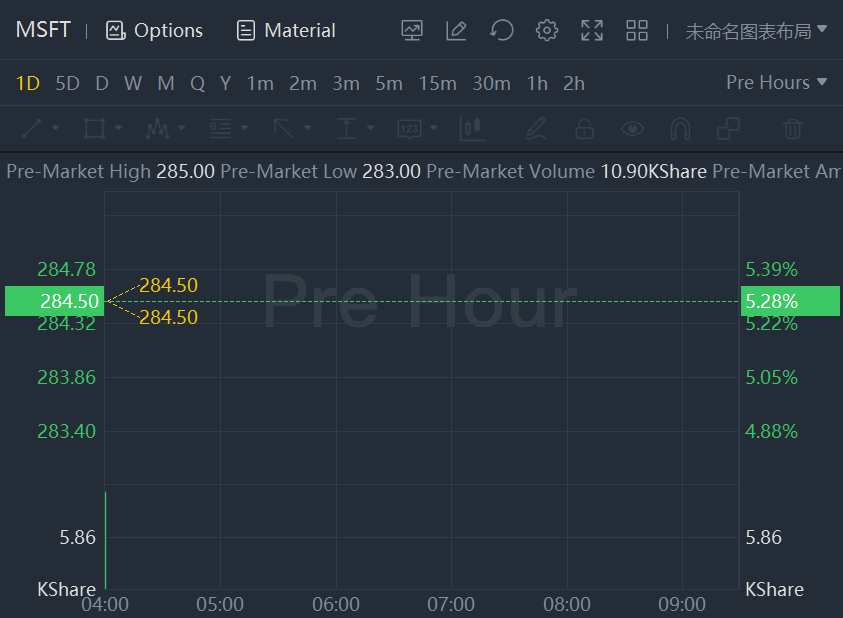Microsoft Corp. reported quarterly sales and earnings that topped analysts’ projections, fueled by robust growth in cloud-services demand. Shares jumped as much as 5% in premarket trading Wednesday.
Revenue in the third quarter, which ended March 31, rose 18% to $49.4 billion, the Redmond, Washington-based software maker said Tuesday in a statement. Net income rose to $16.7 billion, or $2.22 a share. That compared with average analyst projections for $49 billion in sales and $2.19 a share in earnings, according to a Bloomberg survey.
Chief Executive Officer Satya Nadella has built up the company’s two main cloud businesses, Azure and internet-based versions of Office, into steady growth engines that help insulate Microsoft from supply-chain weakness that hurt the availability of PCs and Xbox consoles. Azure -- behind only Amazon.com Inc. in the market for cloud infrastructure services, computing power and storage delivered via the internet -- posted 46% growth, matching the rate in the second quarter and meeting estimates.
“Investors were banking we’d get back on a growth trajectory trend for Azure, as opposed to the deceleration we had in the second quarter,” said Dan Morgan, a senior portfolio manager at Synovus Trust Co., which owns shares of Microsoft.
Microsoft shares alternated between gains and losses in extended trading following the report, eventually soaring as high as $289 as investors digested the company’s results. The stock had declined 3.7% to $270.22 at Tuesday’s close in New York. While the shares jumped 51% in 2021, they have fallen 20% so far this year amid a rout in large technology stocks.
Chief Financial Officer Amy Hood said Xbox hardware revenue, which rose 14%, came in ahead of her expectations, as Microsoft has been able to get more console supplies into stores. Revenue from Xbox content and services climbed 4% in the recent period. The console has gained market share in each of the past two quarters, Nadella told analysts on a conference call.
Azure’s 49% growth rate in constant currency terms was also higher than forecast, Hood said. The company saw strength in commercial bookings, a measure of future revenue, with multiyear deals for Office 365, Microsoft 365 and Azure fueling growth. The contract renewals illustrate satisfaction with Microsoft’s cloud products, she said. “There’s nothing like the moment where you ask people to pay you again and commit again to know that they’re getting great value,” she said in an interview.
On a call with analysts, Hood said that excluding the impact of currency fluctuations, Azure revenue growth will be 2% slower in the fiscal fourth quarter compared with the previous period. Still, that would be higher than many analysts’ estimates, which were more like 40%, said Dan Ives, an analyst at Wedbush.
Hood’s projections for each of the company’s three divisions were in line with analysts’ estimates. While those forecasts take into account the current computer and console supply disruptions because of Covid-19-related shutdowns in China, if that situation persists it could worsen results, she said.
For the third quarter, overall corporate cloud revenue rose 32% to $23.4 billion. Gross margin, the percentage of sales left after subtracting production costs, narrowed “slightly” to 70% in the cloud business, the company said in an earnings slide presentation on its website. Excluding an accounting change, margin would have widened by 3%.
The software giant’s financial report comes two days ahead of cloud rival Amazon. Google, which is trying to catch Microsoft, on Tuesday posted cloud unit sales advanced 44%. International Business Machines Corp. last week reported sales that topped analysts’ estimates on the strength of its hybrid-cloud offerings, indicating healthy demand for corporate software that should boost Microsoft as well, Morgan said.
Sales of Office 365 to business customers rose 17%, and revenue from Windows operating-system software sold to PC makers rose 11%.
In the Productivity and Business Processes unit, sales jumped 17% to $15.8 billion, in line with forecasts. Revenue from LinkedIn, which is included in that division, increased 34% from a year earlier. Intelligent Cloud unit sales rose 26% to $19.1 billion, exceeding projections for $18.9 billion. The More Personal Computing division posted an 11% gain in revenue to $14.5 billion, also topping estimates.

Comments